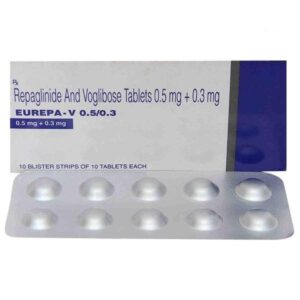REPAGLINIDE + VOGLIBOSE
Repaglinide: Repaglinide is an oral medication used for the treatment of type 2 diabetes mellitus. It belongs to the class of drugs known as meglitinides, which work by stimulating the release of insulin from the pancreas in response to meals. This helps to lower blood sugar levels after eating.
The recommended dose of repaglinide varies depending on the individual’s condition and response to treatment. Typically, it is taken before each main meal, with the dosage ranging from 0.5 to 4 milligrams per day. It is important to follow the instructions provided by the healthcare provider and not to exceed the prescribed dose.
Common side effects of repaglinide may include hypoglycemia (low blood sugar), weight gain, headache, dizziness, nausea, and joint pain. If hypoglycemia occurs, it can manifest as symptoms such as sweating, trembling, hunger, blurred vision, and difficulty concentrating. It is crucial to monitor blood sugar levels regularly while taking this medication to avoid low blood sugar episodes.
In rare cases, repaglinide may cause more severe side effects, such as liver problems, allergic reactions, or a blood disorder called thrombocytopenia. These side effects should be reported to a healthcare provider immediately.
It is essential to note that repaglinide should not be used to treat type 1 diabetes or diabetic ketoacidosis. Additionally, it may interact with certain medications and should be used cautiously in individuals with liver or kidney problems.
Overall, repaglinide is a medication that helps control blood sugar levels in patients with type 2 diabetes by stimulating insulin production from the pancreas. It is important to closely follow the prescribed dosage and monitor for potential side effects to ensure its safe and effective use.
Voglibose: Voglibose is an oral alpha-glucosidase inhibitor that is used in the treatment of type 2 diabetes mellitus. It works by inhibiting the enzymes in the small intestine that break down carbohydrates, thereby delaying the digestion and absorption of glucose.
The primary use of Voglibose is to help regulate blood sugar levels in individuals with type 2 diabetes. It is often prescribed as an adjunctive therapy, along with diet and exercise, or in combination with other antidiabetic medications such as metformin or sulfonylureas.
The recommended starting dose of Voglibose is 0.2 mg three times a day, taken with meals. Depending on the individual’s response, the dose may be gradually increased up to a maximum of 0.6 mg three times a day.
Common side effects of Voglibose include gastrointestinal disturbances such as flatulence, bloating, abdominal pain, and diarrhea. These side effects are a result of the drug’s mechanism of action and typically subside over time. In rare cases, Voglibose may cause more severe adverse effects such as hypoglycemia (low blood sugar), elevated liver enzymes, or allergic reactions. Patients should monitor their blood sugar levels regularly and report any unusual side effects to their healthcare provider.
It is important to note that Voglibose should not be used in individuals with a history of diabetic ketoacidosis or inflammatory bowel disease. Additionally, individuals with severe kidney or liver problems should use Voglibose with caution and under the supervision of a healthcare professional.
As with any medication, it is crucial to follow the prescribed dosage and instructions provided by a healthcare provider and to discuss any concerns or potential interactions with other medications before beginning Voglibose therapy.

